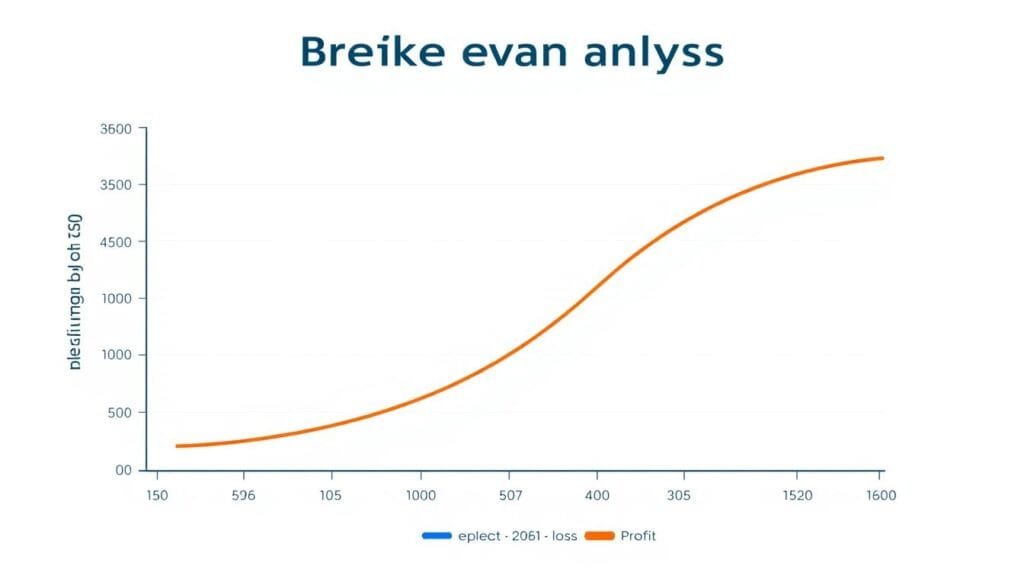Starting a venture without a detailed business plan is like sailing without direction1. It’s vital for both launching startups and guiding existing businesses towards new goals. A well-thought-out business strategy acts as your blueprint2. It helps you align your vision with financial options. This plan lays out how to get funding and grow your business, shaping your strategic journey.
In today’s changing economy, a business plan is crucial, not just a formality1. It clarifies your business model, predicts challenges, and highlights financial needs. A detailed plan turns a vague idea into a clear plan for growth. Research shows that a clear business plan helps founders overcome obstacles and secure investments2. With a solid plan, startups and businesses show they’re prepared for growth and financial health.
Key Takeaways
- A business plan cements the foundation for clear organizational direction and goal-oriented action plans.
- Insights suggest that a thorough market analysis and well-defined financial projections are pillars of a successful plan1.
- Evidence from market studies illuminate the correlation between the existence of a business plan and a startup’s likelihood of thriving2.
- Adherence to a specified structure and the inclusion of key components such as sales strategy and management teams significantly contribute to a plan’s efficacy1.
- Lean startup plans epitomize succinctness, whereas traditional business plans embrace comprehensiveness, with each serving unique business domains and purposes1.
- Funding details and financial protocols in a business plan can often make or break its ability to garner external financial support12.
The Importance of a Business Plan
A solid business plan serves as the foundation for strategy and clarity in an organization. It specifies the company’s aim and outlines how to reach its goals. Through market research, businesses can shape their aims based on real-world data and expected hurdles, making the plan more useful34.
Clarity and Direction
By settling on a clear strategy, a business plan makes the company’s vision concrete. It outlines how to overcome challenges and hit long-term goals. Including in-depth market research, the plan shows who the customers are and who the competitors might be, laying a solid groundwork for business efforts34.
Roadblocks and Solutions
Spotting possible hurdles early on helps businesses come up with ways to deal with them. For example, the plan can predict necessary investments and manage them to avoid overspending. This keeps the business flexible and ready to adapt to market changes4.
Attracting Investment
A detailed business plan is key in drawing investors. It shows a business’s future goals and how profitable it could be. This convinces investors that the leadership team is wise and ready. Studies show that companies with detailed plans are often more successful in getting funds. This highlights the importance of precise planning54.
| Planning Aspect | Impact on Strategic Management |
|---|---|
| Clarity and Direction | Enhances strategic focus and resource alignment |
| Market Research | Ensures the business adapts to market needs and dynamics |
| Roadblocks Identification | Allows preemption of potential challenges, securing continuity |
| Attracting Investment | Increases credibility and attracts financial backing for growth |
Understanding the Basic Structure of a Business Plan
A strategic document vital for outlining business goals and strategies, a business plan is a company roadmap. It is often needed by investors and lenders. It gives a clear view into a company’s main operations and future paths.
The business plan begins with an executive summary. This summary clearly states the business aims and plan highlights. Next, a detailed company description sheds light on the organizational structure, culture, and main business tasks. A deep market analysis is crucial. It shows the competitive scene and target groups6.
Moreover, traditional business plans cover the company’s products or services, management team, and operational strategies. These plans should be thorough and long to meet an investor’s needs7.
On the other hand, lean startup business plans are short. They only highlight key info across nine segments. This approach fits well on just one page, perfect for agile startups7. Updating a business plan often is vital, especially for quickly changing businesses. They might need updates every quarter to stay current6.
The financial section looks into the future of the business’s money matters. It should have predictions like income statements, balance sheets, and cash flows for at least five years. This analysis is key to understanding the business’s potential growth7.
When making your business plan, use these templates as a starting point. Adjust them based on your business needs and market analysis. By matching the plan’s structure with your business goals, you can better tackle market and company challenges. This could lead to significant growth and lasting success6.
How to Make a Business Plan
Making a good business plan is key to getting startup money, setting clear goals, and placing your brand right in the market. A smart plan includes several key parts explained below.
Identifying Your Business Goals and Vision
A vision statement begins with “We will” and describes the impact of your business8. Setting short and long-term goals helps provide direction and purpose, essential for lasting success8. Knowing these goals lets businesses match their daily work with bigger market strategies effectively9.
Market Analysis and Target Audience
Studying the market well is core and should look into strengths, weaknesses, opportunities, and threats8. By understanding your target market with detailed research, you can craft marketing strategies that hit the mark8. Competitive analysis helps know your unique spot and strengths in the market8. This deep understanding leads to strategies that better reach the right people.
Products or Services Offering
Describing your products or services well and showing their benefits is the basis of good market positioning10. It’s crucial to make clear what sets your offers apart from others to catch the target market’s interest9. Drawing in customers with the benefits of your products or services also helps build a loyal following9.
Financial Projections and Funding Needs
Detailed financial planning considers possible earnings, expected expenses, and profit measures like net profit margin10. Telling investors about the money needed, including startup costs and long-term financial outlook, is key for attracting investment9. A carefully estimated financial plan gives investors confidence in the startup’s success and financial health9.

| Category | Year 1 | Year 2 | Year 3 |
|---|---|---|---|
| Revenue | $500,000 | $1,000,000 | $1,500,000 |
| Expenses | $300,000 | $400,000 | $450,000 |
| Net Profit | $200,000 | $600,000 | $1,050,000 |
| Funding Needs | $250,000 | $0 | $0 |
This table shows the financial path expected for the startup, highlighting expected revenue growth, managing costs, and profit margins for three years. By showing clear financial projections, businesses make a strong case for the startup funding they need.
Market Analysis: Knowing Your Industry
A thorough market analysis is crucial for any solid business plan. It gives a detailed look at the competitive landscape, market demand, and industry research1112. It helps us know who our customers are and what they want, making sure we meet their needs and what’s possible in the market13.
Recent stats show the total U.S. sales last year, showing the market’s active changes11. This, along with understanding the industry growth rate over the last few years, tells us where things are going. It helps businesses plan their growth moves12.
| Market Segment | Market Share | Projected Growth |
|---|---|---|
| Major Industry Participants | 45% | 3.5% annually |
| Emerging Competitors | 30% | 5.2% annually |
| Niche Markets | 25% | 2.8% annually |
Key data on who’s buying, based on age, gender, education, and job, prove we need to customize our products11. Competitor analysis helps spot both direct and indirect challengers. It also helps us find new ways to stand out13.
Checking out competitors’ online stuff, like their blogs, social media, and reviews, really shapes what customers think and follow12. Knowing this helps create ads and strategies that really speak to our audience13.

Finally, getting the whole picture of the market is key. It helps businesses plan well, keep going strong, and stay ahead as things change1112.
Financial Planning and Projections
Every business needs solid financial planning and projections for stability and growth. We’ll cover key financial points like startup costs, projected revenues, and planning for the future.
Estimating Startup Costs
First, figuring out startup costs is key. Industry analyses show major expenses in areas such as salaries, rent, and insurance. It’s also smart to plan for unexpected costs, around 10-15% extra14.
Revenue Projections and Break-even Analysis
To set revenue goals, deep market study and cash flow analysis are critical. Monthly checks for the first year15 and a look at past incomes14 help predict future earnings. This approach is vital for a solid break-even point analysis, showing when profits will begin.
Future Financial Planning
Looking ahead up to ten years is crucial for a business’s health. Projections should consider the best, worst, and most likely future scenarios15. Tools like FreshBooks are great for these detailed forecasts14.

| Year | Optimistic Scenario | Most Likely Scenario | Pessimistic Scenario |
|---|---|---|---|
| 1 | $500K | $350K | $200K |
| 2 | $750K | $500K | $300K |
| 3 | $1M | $700K | $400K |
Using strategic forecasts14 and comparing them with real results15 keeps a business on track. This ensures steady revenue growth and prepares for any future hurdles.
Marketing and Sales Strategy
To thrive today, combining smart marketing with effective sales is key. It boosts your brand and keeps money coming in through targeted customer outreach. By engaging and wooing customers, your brand grows strong and steady.
Defining Your Marketing Plan
Start your digital marketing with clear, measurable goals. Goals that match your big plan. A strong brand image is vital. It makes customers stick by you16. Use cost-effective methods like word-of-mouth and public relations to spread the word without spending much16. Also, know your marketing costs. This helps manage your budget better16.
Sales Strategy and Revenue Channels
- Picking a sales strategy means looking closely at how and where you’ll sell. Starting with one channel makes it easier to get noticed before growing bigger16.
- A good sales plan has specific goals over time, like by the quarter or semester. This makes it easier to manage and track17.
- Your sales approach should also reflect your company’s past successes and future goals. This balance builds customer loyalty and boosts sales17.
Online Marketing and Social Media Presence
Having a strong online and social media presence is crucial. Using SEO and being active on social media can reach more people. This not only makes your brand well-known but also builds a community around it. It’s where customers can talk and give feedback.
Conclusion
As we wrap up the business plan, it’s crucial to take a strategic look. This involves highlighting key actions for long-term success. We must summarize important parts like market analysis and strategy, adding stats and visuals for clarity1819. Startups need to show their funding needs and launch plans. Established businesses should share their goals and past wins in this section19.
The conclusion’s placement can change. It may follow an engaging summary to catch investor interest right away. Or, it can confirm the business’s strengths at the end1819. Regardless, it must spotlight the company’s benefits, show leadership skills, and argue for success, especially when seeking funds20. It needs to make the reader want to act, either to invest or to partner1819.
Proofreading thoroughly is key. Any error can hurt the whole plan’s trustworthiness, impacting the reader’s view181920. With correct facts, a professional style, and a strong finish that echoes the business’s aim, a good conclusion can win investor trust. It sets the stage for a successful future20.
FAQ
What are the key reasons to create a business plan?
A business plan gives clear directions and outlines your strategy. It spots problems ahead and suggests solutions. It also helps draw in investors by showing your business’s potential.
What should a basic structure of a business plan include?
Start with an executive summary and a description of your company. Include market analysis and details on your organizational setup. Explain your products or services, market plans, operations, and financial forecasts.
How can I establish clear business goals and vision in my plan?
Begin by defining your business’s mission. Describe how you’ll meet market needs and outdo rivals. This will set your market position and strategy.
Why is market analysis such an important part of a business plan?
Market analysis shows you know your industry and market size. It proves people want your products. It also checks out the competition and backs up your business idea.
How do I prepare financial projections for my business plan?
Calculate initial costs and predict profit and revenues. Do a break-even analysis and plot future finances. Use real data and plan for different outcomes to convince investors.
What kind of marketing and sales strategies should be included in my business plan?
Explain how you’ll reach customers and push your product. Your sales plan should show how you’ll make money. Highlight your online marketing and social media use too.
How detailed should my products or services section be in the business plan?
Describe your offerings in detail. Talk about what sets them apart, their benefits, and market fit. Make it clear to investors what you’re selling and its value.
What is the purpose of the executive summary in a business plan?
The executive summary is your plan’s intro, showing key points. Though it’s written last, it highlights your goals and market strategy. It draws readers into the rest of your plan.
How often should I review and update my business plan?
Update your plan regularly, especially when market, operational, or financial changes occur. Keeping it current helps your strategy stay effective and relevant.
Can a business plan help in managing a company’s day-to-day operations?
Yes. A business plan guides how you operate daily. It aligns everyday tasks with long-term goals, ensuring steady progress towards your vision.
Should I include risk management strategies in my business plan?
Definitely. Show you’ve thought about potential risks and how to tackle them. This reassures investors and stakeholders of your preparedness.
What makes a business plan persuasive to investors and lenders?
A strong plan argues well for your business’s success. It should have thorough market research, believable financial figures, and highlight your strategic edge. Being transparent and professional with evidence-based plans wins over investors and lenders.
